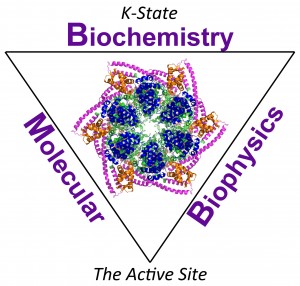 The Department underwent some changes this fall. First and foremost, we welcomed our new Department Head, Phillip E. Klebba, who joined us from Oklahoma. We also began a faculty search and revamped our undergraduate curriculum. Most public change: our new name.
The Department underwent some changes this fall. First and foremost, we welcomed our new Department Head, Phillip E. Klebba, who joined us from Oklahoma. We also began a faculty search and revamped our undergraduate curriculum. Most public change: our new name.
Many professors in the department have diverged into biophysical science in their research. Grad Chair Michal Zolkiewski noted that while the name is new, the research is not. Zolkiewski, a biophysicist himself, described the discipline as “using physical principles to understand how different molecules participate in life processes.” When added to biochemistry, this offers a more complete view of these processes. Zolkiewski continued, “Biophysics brings new approaches that aren’t available in more traditional biochemistry, it will open opportunities for new collaborations and projects, and potentially some new funding.”
Professor Michal Zolkiewski also emphasized one major benefit within the department: “I think we’ll reach a much wider group of graduate students because of the new department title… especially students interested in biophysical research.”
Does a diverse student body necessarily make a better department? Dr. Ramaswamy Krishnamoorthi thinks so. “By attracting suitable students for faculty to work with, the overall research efforts of the faculty will be enhanced,” Krish said. “A large number of the faculty members already do this kind of research. Hopefully, it will increase the research we’re able to do… [and] put K-State on the map for biophysical research.”
Dr. Larry Davis has been doing biophysical research for the department since the mid 1970’s. His background in plant biochemistry and molecular biology has led to great success in understanding pathways of remediation of contaminants found in soil and water. Using biophysics he has analyzed water uptake in plants. “The first few years of my research, we did basic biophysics, things like how proteins associate with one another, and how gas substrates find enzymes to react with,” Davis said. “We then made more applied biophysical breakthroughs – how molecules get from where they are to where in the plant they’re cleaned up, which is all about diffusion. The next stages of my research involved primarily get from where they are to where in the plant they’re cleaned up, which biochemistry, because we were trying to see what it is the plants do to filter [contaminants] out.”
Because of this crossover, Davis sees scientific fields as a Venn diagram, constantly overlapping. “The disciplinary boundaries set up by universities are very artificial,” Davis said. “The name change is not really changing what we’re doing but stating it more clearly.